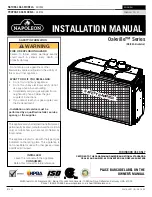
Page 6
433-1390G
September 1, 2008
R
7100FP EPA Woodburning Fireplace
2
Getting Started
A. Design and Installation Considerations
C. Negative Pressure
Draft is the pressure difference needed to vent fireplaces
successfully. Considerations for successful draft include:
• Preventing negative pressure
• Location of fireplace and chimney
Negative pressure
results from the imbalance of air avail-
able for the fireplace to operate properly. Causes for this
imbalance include:
• Exhaust fans (kitchen, bath, etc.).
• Range
hoods.
• Combustion air requirements for furnaces, water heaters
and other combustion appliances.
• Clothes
dryers.
• L o c a t i o n o f r e t u r n - a i r v e n t s t o f u r n a c e o r a i r
conditioning.
• Imbalances of the HVAC air handling system.
• Upper level air leaks: recessed lighting, attic hatch
opening, duct leaks.
Check building codes prior to installation.
• Installation MUST comply with local, regional,
state and national codes and regulations.
•
Consult insurance carrier, local building inspector,
fire officials or authorities having jurisdiction about
restrictions, installation inspection and permits.
CAUTION
When planning a fireplace installation, it is necessary to de-
termine the following information before installing:
• Where the fireplace is to be installed. See Sections
3 and 4.
• The vent system configuration to be used. See Sections
5 and 6.
• Electrical wiring. See Section 3.
• Framing and finishing details. See Sections 3, 6 and 8.
• Whether optional accessories are desired. See
Section 12.
B. Fire Safety
To provide reasonable fire safety, the following should be
given serious consideration:
1. Install at least one smoke detector on each floor of
your home to ensure your safety. They should be
located away from the heating appliance and close
to the sleeping areas. Follow the smoke detector
manufacturer’s placement and installation instructions,
and be sure to maintain regularly.
2. A conveniently located Class A fire extinguisher
to contend with small fires resulting from burning
embers.
3.
A practiced evacuation plan, consisting of at least two
escape routes.
4.
A plan to deal with a chimney fire as follows:
In the event of a chimney fire:
a
Evacuate the house immediately
b.
Notify fire department
Fire Risk.
WARNING
• Do not operate appliance before reading and
understanding operating instructions.
• Failure to operate appliance properly may
cause a house fire.
• Installation and use of any damaged appliance.
• Modification of the appliance.
• Installation other than as instructed by Hearth & Home
Technologies.
• Installation and/or use of any component part not approved
by Hearth & Home Technologies.
• Operating appliance without fully assembling all
components.
• Operating appliance without legs attached (if supplied with
unit).
• Do NOT Overfire - If appliance or chimney connector glows,
you are overfiring.
Any such action that may cause a fire hazard.
WARNING
Fire Risk.
Hearth & Home Technologies disclaims any
responsibility for, and the warranty will be
voided by, the following actions:







































